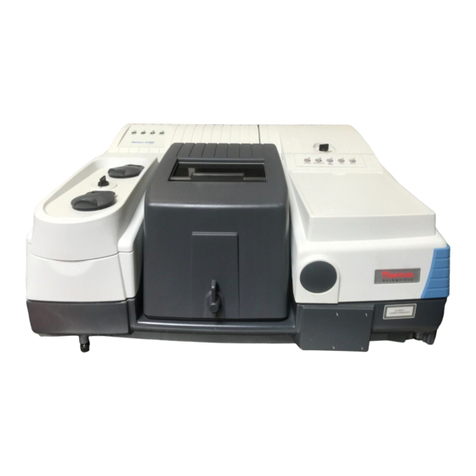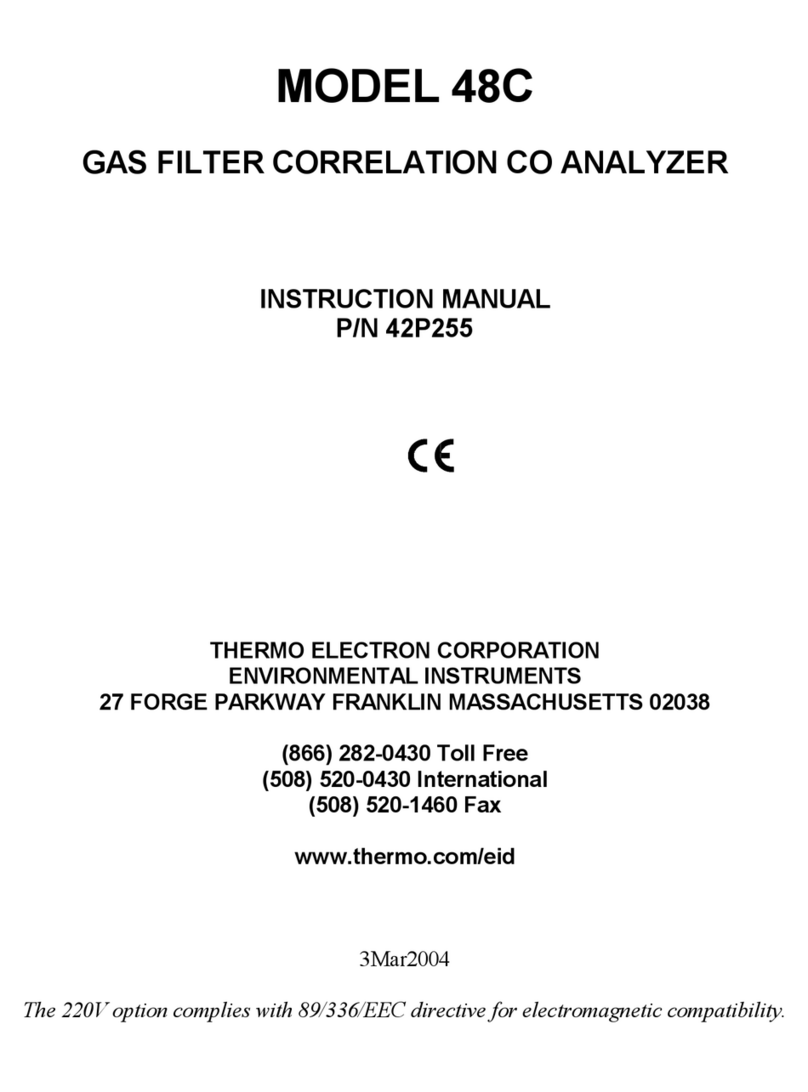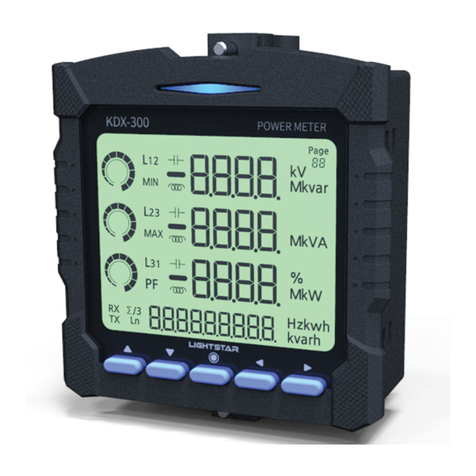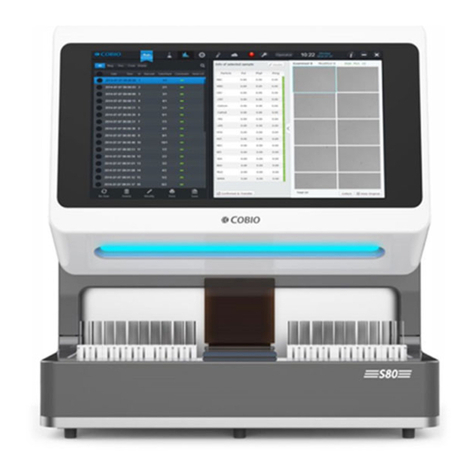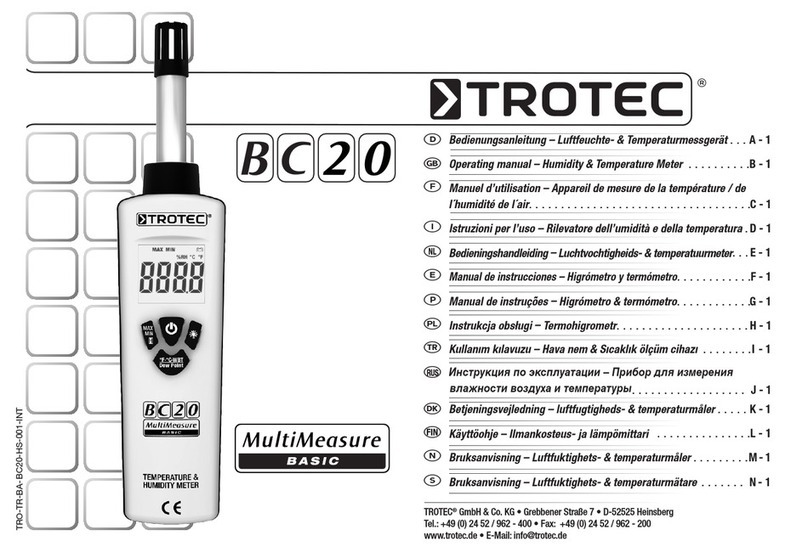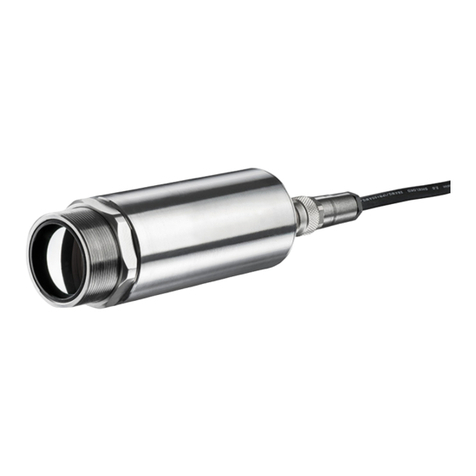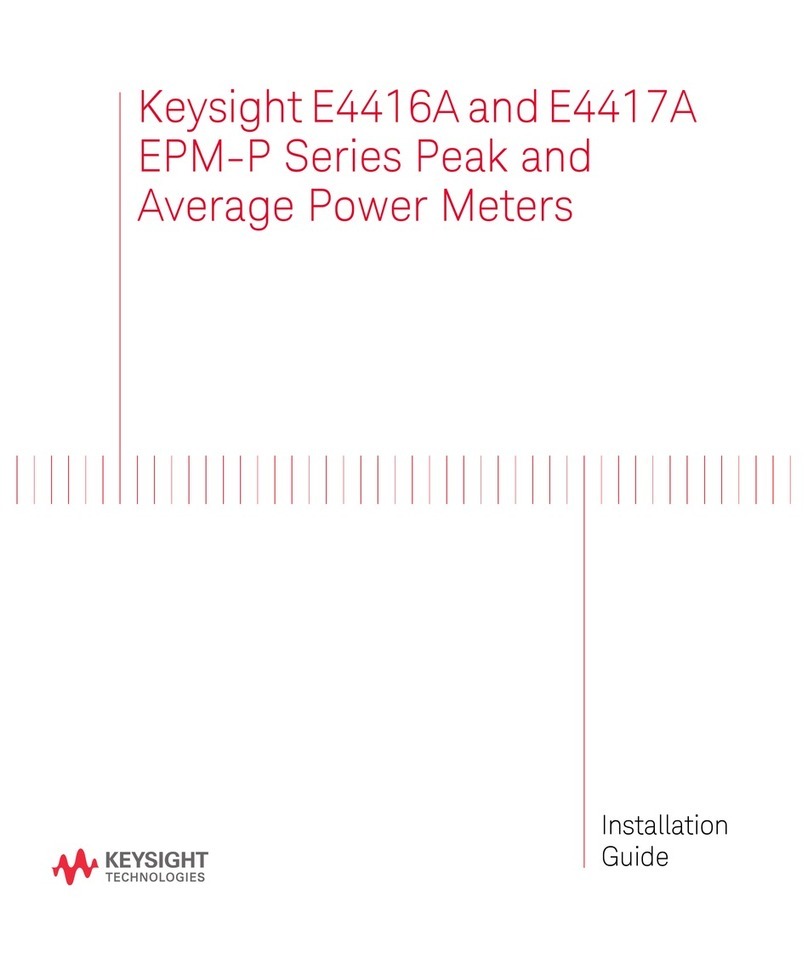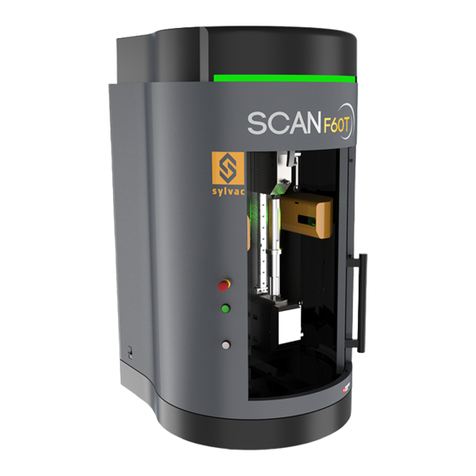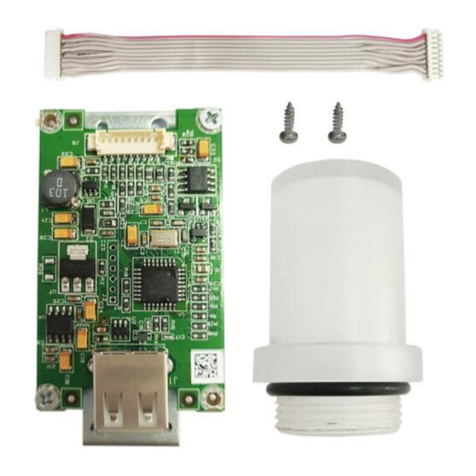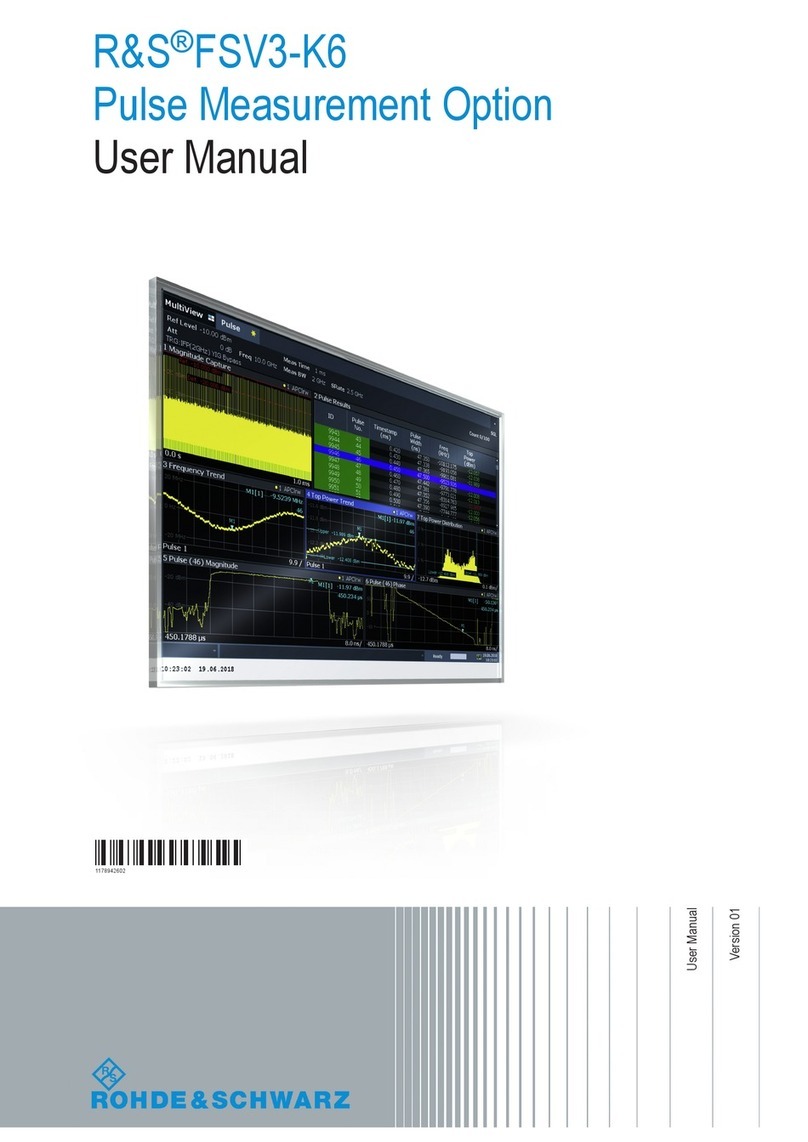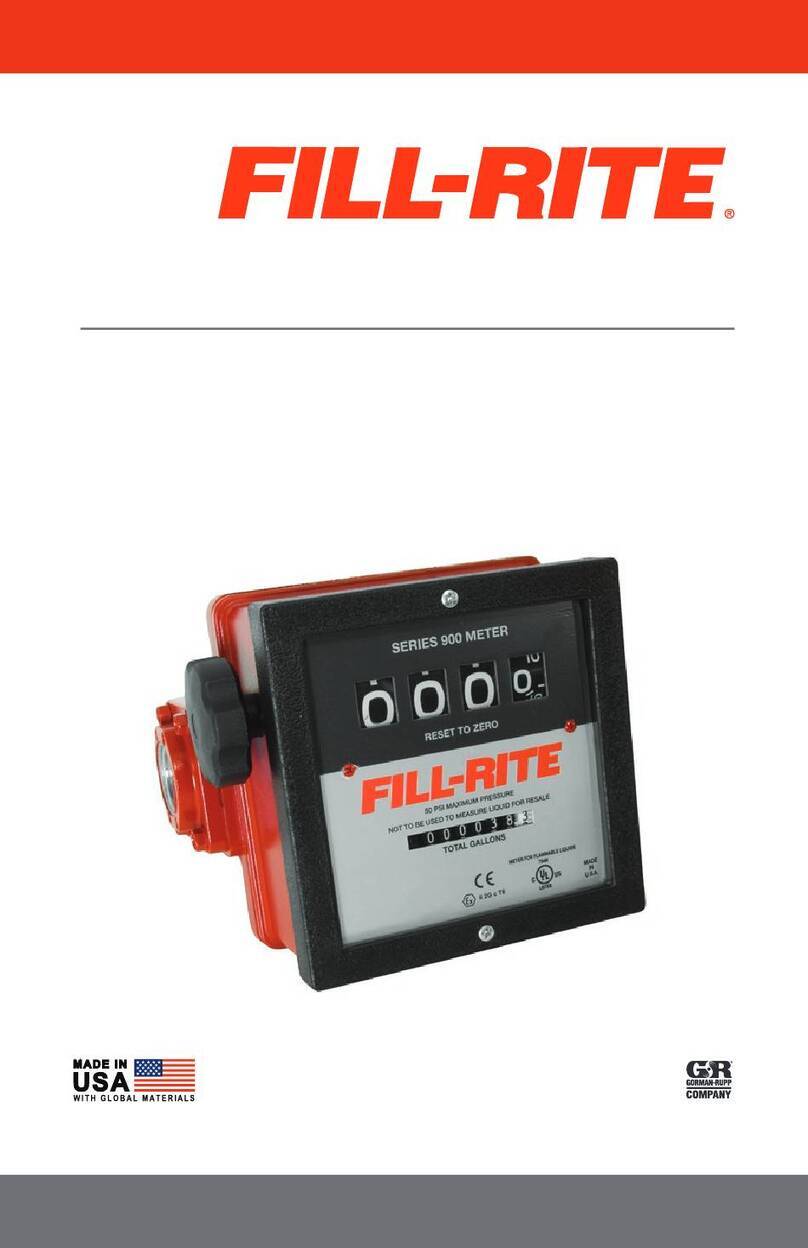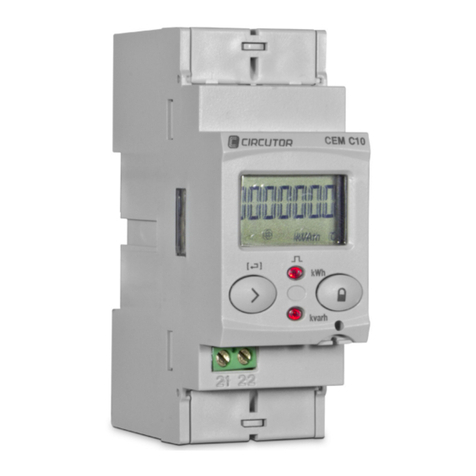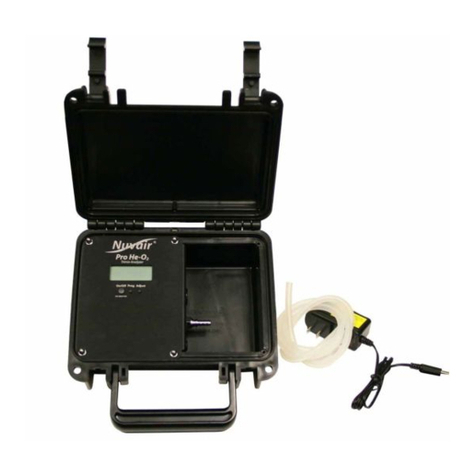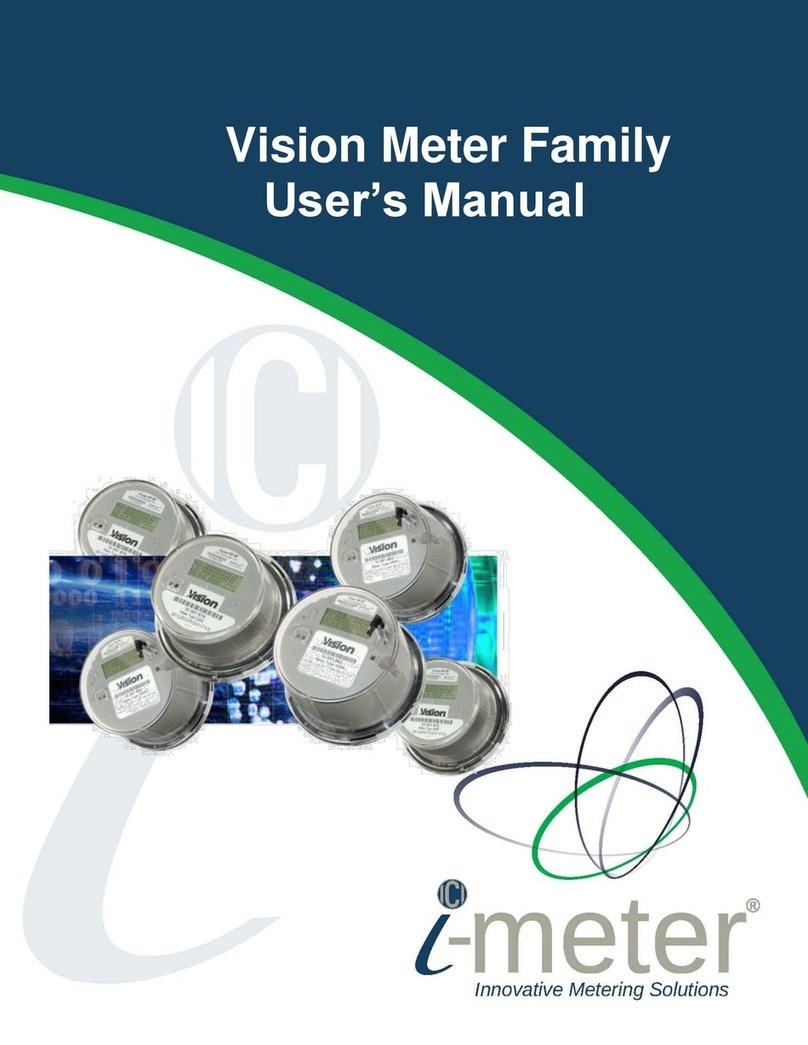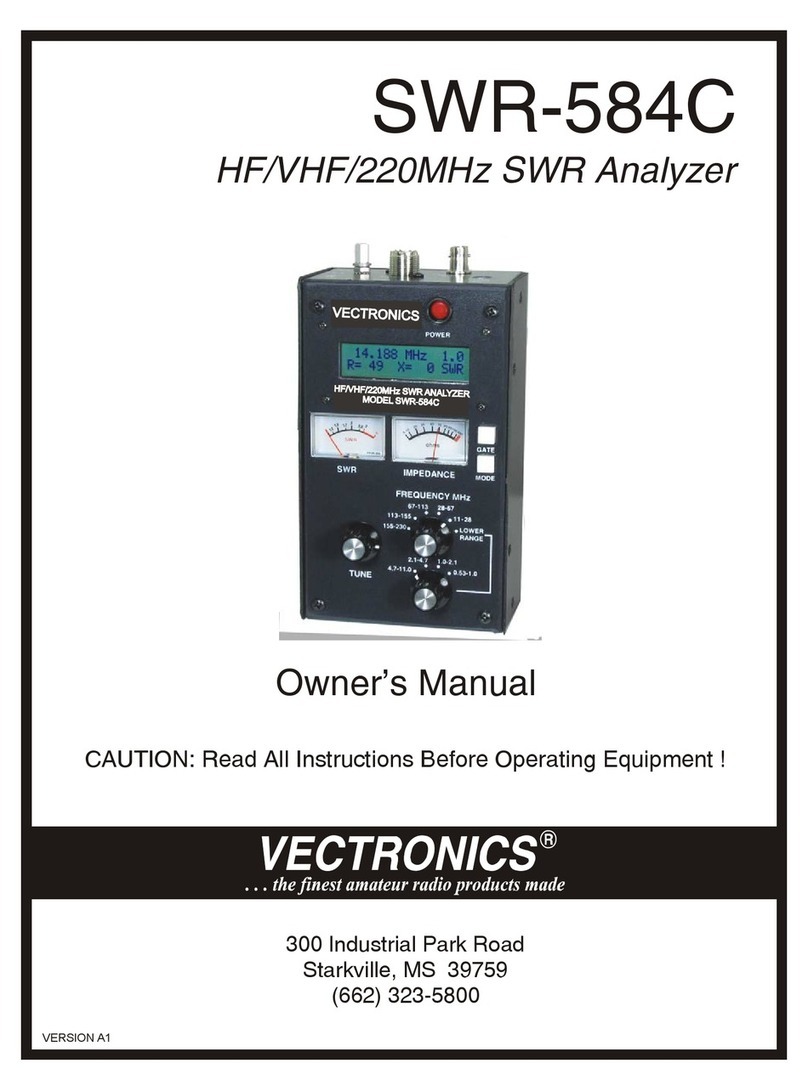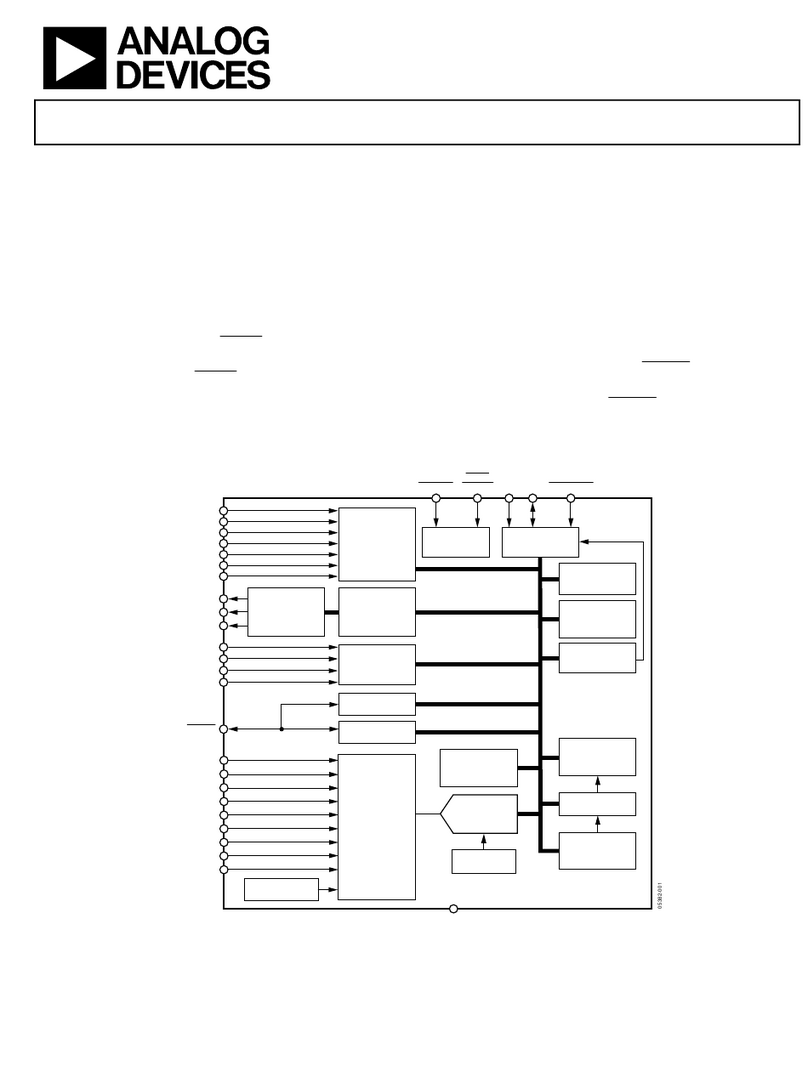Thermo Electron EPD MK2 User manual

EPD/HB/40521/000
EPD MK2
Beta/Gamma Sensitive
Electronic Personal Dosemeter
Technical Manual
February 2004


© Thermo Electron Corporation 2004
ALL RIGHTS RESERVED.
REPRODUCTION IN WHOLE OR IN PART OF ALL MATERIAL
IN THIS PUBLICATION, INCLUDING DRAWINGS AND
DIAGRAMS, IS FORBIDDEN.
THIS INSTRUCTION MANUAL IS CONFIDENTIAL TO THERMO
ELECTRON CORPORATION AND IS SUPPLIED FOR USE
ONLY IN CONNECTION WITH THE OPERATION AND/OR
MAINTENANCE OF THE EQUIPMENT TO WHICH IT
RELATES, AS SUPPLIED BY THERMO ELECTRON
CORPORATION. THE CONTENTS MUST NOT BE USED FOR
OTHER PURPOSES, NOR DISCLOSED TO ANY THIRD
PARTY, WITHOUT THE PRIOR WRITTEN CONSENT OF
THERMO ELECTRON CORPORATION.
Thermo Electron Corporation
Sopers Lane, Poole, Dorset BH17 7ER. England.
Tel:01202 782740 Fax: 01202 782056


ELECTRONIC PERSONAL DOSEMETER HANDBOOK EPD/HB/40521/000
MANUFACTURERS DETAILS & ISSUE STATE
ISSUE 5
Thermo Page (i)
MANUFACTURERS DETAILS
Manufacturer's Address
Thermo Electron Corporation
Environmental Instruments Division
Radiation Measurement & Protection
Sopers Lane
Poole
Dorset
United Kingdom
BH17 7ER
e-mail: service.e[email protected]m
Tel. (01202) 782740
Fax. (01202) 782056
USA Sales Office
Thermo Electron Corporation
Environmental Instruments Division
Radiation Measurement & Protection
105C Hembree Park Drive
Roswell
Georgia 30076
U.S.A.
Tel. 770 521 4500
Fax. 770 521 4535
ISSUE STATE
Pages Issue Type Part ID File ID Change Ref
Front Sheet 5 ESERS EPD/HB/40521/000 HB40521_000_
cover_iss5 550014
Balance 5 ESERS EPD/HB/40521/000 HB40521_000_
Iss5 550014


ELECTRONIC PERSONAL DOSEMETER HANDBOOK EPD/HB/40521/000
CONTENTS
ISSUE 5
Thermo Page (iii)
CONTENTS
Page
GLOSSARY ...............................................................................................................................VII
WARNINGS AND CAUTIONS....................................................................................................IX
SECTION 1................................................................................................................................... 1
INTRODUCTION.......................................................................................................................... 1
1.1 GENERAL...................................................................................................................... 1
1.2 EPD MAJOR CHARACTERISTICS.................................................................................... 2
1.3 BRIEF FUNCTIONAL DESCRIPTION .................................................................................. 3
SECTION 2................................................................................................................................... 5
GETTING STARTED ................................................................................................................... 5
2.1 SETTING-UP .................................................................................................................. 5
2.1.1 Unpacking The EPD............................................................................................... 6
2.1.2 The EPD Battery..................................................................................................... 6
2.1.3 Start-up Sequence..................................................................................................9
2.1.4 EPD Confidence Test...........................................................................................10
2.1.5 Issuing an EPD.....................................................................................................10
2.1.6 Wearing an EPD................................................................................................... 11
SECTION 3................................................................................................................................. 13
OPERATING INSTRUCTIONS.................................................................................................. 13
3.1 LCD DISPLAY AND BACKLIGHT ................................................................................... 13
3.2 AUDIBLE AND VISIBLE ALARMS ................................................................................... 16
3.2.1 Alarm features ......................................................................................................16
3.2.2 Dose Alarms.........................................................................................................20
3.2.3 Dose Rate Alarms ................................................................................................ 20
3.2.4 Over-Range Indication..........................................................................................21
3.2.5 Alarm Muting.........................................................................................................22
3.3 BUTTON OPERATION AND DISPLAY SELECTION ............................................................ 23
3.4 LCD DISPLAY LOCK-ON FACILITY ............................................................................... 24
3.5 DISPLAY OPTIONS AND BUTTON FUNCTIONS ................................................................ 26
3.5.1 Displaying Hp (10) Dose, Dose Rate and User ID...............................................26
3.5.2 Displaying Hp(0.07) Doses, Dose Rate and ADS User ID...................................27
3.5.3 Displaying Total Dose...........................................................................................30
3.5.4 Starting/Stopping The Seconds Count Down Timer ............................................30
3.5.5 Turning the EPD off..............................................................................................31
3.5.6 Displaying Peaks (Rate High) ..............................................................................32
3.5.7 EPD Confidence Test...........................................................................................32
3.5.8 Clearing Dose Displays........................................................................................34
3.5.9 Displaying/Setting Dose Alarm Thresholds..........................................................34
3.5.10 Displaying/Setting Dose Rate Alarm On/Off Thresholds ................................. 36
3.5.11 Setting The Sounder ........................................................................................ 38

EPD/HB/40521/000 ELECTRONIC PERSONAL DOSEMETER HANDBOOK
CONTENTS
ISSUE 5
Page (iv) Thermo
SECTION 4................................................................................................................................. 41
TECHNICAL DESCRIPTION.....................................................................................................41
4.1 GENERAL ................................................................................................................... 41
4.2 ELECTRICAL DESCRIPTION.......................................................................................... 42
4.2.1 Electrical Characteristics...................................................................................... 42
4.2.2 Battery Management ............................................................................................ 42
4.2.3 On / Off Operating Modes .................................................................................... 44
4.3 MECHANICAL DESCRIPTION ......................................................................................... 45
4.3.1 Mechanical Characteristics And Dimensions.......................................................45
4.3.2 Brief Mechanical Description................................................................................ 45
4.4 ENVIRONMENTAL DESCRIPTION ................................................................................... 47
4.4.1 Environmental Characteristics..............................................................................47
4.4.2 Brief Environmental Description........................................................................... 47
4.5 INFRA-RED INTERFACE ................................................................................................ 48
4.5.1 Communicating With The EPD............................................................................. 48
4.5.2 EPD Configuration via the IR Communications Links.......................................... 49
4.6 EPD INTERNAL PROCESSING & FACILITIES .................................................................. 51
4.6.1 Memory Characteristics:.......................................................................................51
4.6.2 Alarm Characteristics: .......................................................................................... 52
4.6.3 Default Display ..................................................................................................... 52
4.6.4 User Identification................................................................................................. 52
4.6.5 Dose and Dose Rate............................................................................................ 53
Dose......................................................................................................................... 53
Dose Rate ................................................................................................................ 53
4.6.6 Counts .................................................................................................................. 54
4.6.7 Dose Quality Flags...............................................................................................55
(i) Reset Count........................................................................................................ 55
(ii) Knock Time Seconds ......................................................................................... 55
(iii) Dose Over-range...............................................................................................55
(iv) Dose Rate Over-range......................................................................................56
(v) Counter Over-range........................................................................................... 56
(vi) Abuse Warning..................................................................................................56
(vii) CRC Failure......................................................................................................56
(viii) Low Voltage (EPD firmware version 11 and later)..........................................56
(ix) Detector Fault (EPD firmware version 11 and later)........................................ 56
4.6.8 Dose And Dose Rate Alarm Processing ..............................................................56
4.6.9 EPD Operating Status ..........................................................................................57
EPD ‘Run’ and Off times .......................................................................................... 58
EPD State................................................................................................................. 58
Alarms ......................................................................................................................58
Faults........................................................................................................................58
4.6.10 Dose Profile......................................................................................................60
4.6.11 Event History Store .......................................................................................... 61

ELECTRONIC PERSONAL DOSEMETER HANDBOOK EPD/HB/40521/000
CONTENTS
ISSUE 5
Thermo Page (v)
SECTION 5................................................................................................................................. 63
EPD FAULTS AND RECOVERY ACTIONS ............................................................................. 63
5.1 OVERVIEW .................................................................................................................. 63
5.2 VISUAL AND AUDIBLE FAULT INDICATION ..................................................................... 64
5.3 INTERNAL LOGGING OF FAULT CONDITIONS.................................................................. 65
5.3.1 EPD Status Faults Record....................................................................................65
5.3.2 Event History store ............................................................................................... 65
5.3.3 Dose Quality Factors............................................................................................66
5.4 BLANK LCD DISPLAY AND OTHER FAULTS .................................................................. 67
5.5 INITIALISATION ERROR ( LCD ---- ) ............................................................................. 69
5.6 COMMUNICATIONS ERROR ( LCD ≡≡≡≡ ) .................................................................... 69
5.7 LCD DISPLAY ERROR CODES ..................................................................................... 71
5.8 RECOVERY PROCEDURES ............................................................................................ 72
5.8.1 Logging Faults / Extracting Data .......................................................................... 72
5.8.2 Clearing faults....................................................................................................... 72
SECTION 6................................................................................................................................. 79
MAINTENANCE......................................................................................................................... 79
6.1 CALIBRATION .............................................................................................................. 79
6.2 THE EPD BATTERY..................................................................................................... 82
6.2.1 Replacement Batteries......................................................................................... 82
6.2.2 Battery Leakage ................................................................................................... 82
6.2.3 Lithium Thionyl Chloride Battery Warning............................................................ 82
6.2.4 Replacing the EPD Battery...................................................................................84
6.3 EPD CLIP ASSEMBLY ................................................................................................. 86
6.3.1 Removing the EPD Lanyard Plate/Clip Assembly................................................87
6.3.2 Replacing The EPD Lanyard Plate/Clip Assembly...............................................88
6.4 CLEANING................................................................................................................... 89
6.4.1 General Cleaning.................................................................................................. 89
6.4.2 Radiological Cleaning...........................................................................................89
6.4.3 Cleaning after a Battery Leakage.........................................................................89
6.4.4 Periodic Cleaning ................................................................................................. 90
APPENDIX A .............................................................................................................................91
RADIOLOGICAL SPECIFICATIONS........................................................................................ 91
APPENDIX B .............................................................................................................................93
ELECTROMAGNETIC COMPATIBILITY.................................................................................. 93
APPENDIX C .............................................................................................................................97
SUMMARY OF GENERAL PHYSICAL & FUNCTIONAL CHARACTERISTICS..................97
APPENDIX D ...........................................................................................................................102
EPD FAULT LOG FORM.........................................................................................................103


ELECTRONIC PERSONAL DOSEMETER HANDBOOK EPD/HB/40521/000
GLOSSARY
ISSUE 5
Thermo Page (vii)
GLOSSARY
/h Per hour
°C Degrees Celsius
ADS Approved Dosimetry Service (or System)
CRC Cyclic Redundancy Check. Error checking code.
dB(A) Decibels - ‘A’ weighted scale (sound intensity)
DC Direct Current
DDE Deep Dose Equivalent (alternative nomenclature for Hp(10))
Dose The accumulated dose to which alarm thresholds apply, intended for
tactical dose monitoring (eg. per day, per week, per shift etc)
Double-press Pressing the button twice in quick succession
EEPROM Electrically Erasable Programmable Read Only Memory
EPD Electronic Personal Dosemeter
EPDS Electronic Personal Dosimetry System
eV Electron Volt
Gy Gray, SI unit of dose
HEX Hexadecimal
H10 EPD LCD nomenclature for personal dose (Hp(10))
H07 EPD LCD nomenclature for personal dose (Hp(0.07))
H10/h EPD LCD nomenclature for dose rate (Hp(10)/h)
H07/h EPD LCD nomenclature for dose rate (Hp(0.07)/h)
Hp(10) Personal dose equivalent at a depth of 10mm of tissue (‘penetrating’,
‘deep’ or ‘whole body’ dose).
Hp(0.07) Personal dose equivalent at a depth of 0.07 mm of tissue
(‘superficial’, ‘shallow’ or ‘skin’ dose).
Hp(10)/h Hp(10) dose rate
Hp(0.07)/h Hp(0.07) dose rate
ICRU International Commission on Radiation Units
ID Identification
IR Infra-red
IrDA Infra-red Data Association
keV Kilo Electron Volt
LCD Liquid Crystal Display
LED Light Emitting Diode
Long Press Pressing and holding the button
LTC Lithium Thionyl Chloride (Sulphurous Oxychloride, SOCl2)
MeV Mega Electron Volt
m metre/milli
mm millimetre
nm nanometre
NRPB National Radiological Protection Board - the statutory authority for
radiological protection in the UK
PCB Printed Circuit Board

EPD/HB/40521/000 ELECTRONIC PERSONAL DOSEMETER HANDBOOK
GLOSSARY
ISSUE 5
Page (viii) Thermo
Glossary (continued)
PTB The Physikalisch-Technische Bundesanstalt, Braunschweig
and Berlin. The national institute of natural and engineering
sciences and the highest technical authority for metrology and
physical safety engineering of the Federal Republic of
Germany.
SDE Shallow Dose Equivalent (alternative nomenclature for Hp(0.07))
ppm Parts per million
RAM Random Access Memory
rem A unit of dose equivalent, equal to 10mSv
RFI Radio Frequency Interference
Short-press A short press and release of the button
Sv Sievert, SI unit of dose equivalent
T Tesla
TLD Thermoluminescent Dosemeter
Total Dose Intended to be a secure record of the total accumulated dose
received since Dosemeter issue - alarms do not apply to total dose.
User ID A numeric code of up to 12 digits that may be written to the EPD to
define the current user or wearer. By convention a value of
FFFFFFFFFFFF is written to EPDs not currently issued to a wearer.
User Name A character string of up to 22 characters that may be written to the
EPD and used as a second or supplementary Wearer Identity
( Supplementary to user ID ).
Wearer ID Alternative terminology for the User ID.
Wearer Name Alternative terminology for the User Name.

ELECTRONIC PERSONAL DOSEMETER HANDBOOK EPD/HB/40521/000
WARNINGS AND CAUTIONS
ISSUE 5
Thermo Page (ix)
WARNINGS
Radioactive Contamination
DURING OPERATIONAL USE THE EPD MAY BECOME EXPOSED TO RADIOACTIVE
CONTAMINATION. THE EPD MUST BE SUBJECT TO ALL RELEVANT
DECONTAMINATION PROCEDURES LAID DOWN BY THE RADIOLOGICAL
PROTECTION AUTHORITY.
Lithium Thionyl Chloride Batteries
LITHIUM THIONYL CHLORIDE* (LTC) BATTERIES ARE POTENTIALLY DANGEROUS.
THEY MAY LEAK TOXIC SUBSTANCES THAT CAN BE HARMFUL. READ AND TAKE
NOTE OF THE MANUFACTURERS WARNINGS ON THE BATTERY CASE. READ ALSO
THE DETAILED LTC BATTERY WARNINGS IN THIS HANDBOOK.
* Sulphurous Oxychloride, SOCL2
Cautions
EPD batteries
Batteries are susceptible to fire and abuse. Some manufacturers provide batteries with a
safety vent, which allows a controlled release of electrolyte if fire and abuse conditions
prevail. If the EPD has been damaged in a manner that could affect the battery, care must
be exercised during battery removal. The battery may have vented into the EPD case and
caused the EPD to become pressurised.
EPD Battery Cap
Take care when removing the EPD battery cap, the battery cap may spring free with
unexpected force.


ELECTRONIC PERSONAL DOSEMETER HANDBOOK EPD/HB/40521/000
INTRODUCTION
ISSUE 5
Thermo Page 1
SECTION 1
INTRODUCTION
This handbook is for the Thermo Electron Corporation Electronic Personal
Dosemeter (EPD), Beat/Gamma variant, Mks 2.0, 2.1, 2.2 & 2.3. The EPD Mk2
family is lighter and slimmer than the original Mk1 EPD and has new micro-
circuitry, case design and software. The Mk2 EPDs also have a number of
enhanced dosimetry features and user functions. To simplify nomenclature the
term EPD has been used throughout this handbook and should be read to signify
the EPD Mk2 Beta/Gamma dosemeter.
1.1 General
The EPD is a personal radiation monitor that detects and measures beta and
gamma radiation. Radiation that is detected by the EPD is processed to give an
indication of penetrating dose, superficial dose and the dose rates. This
information is displayed to the user via an LCD display on the top of the EPD.
The EPD contains three silicon diode detectors. Each detector feeds a chain of
dedicated amplifiers and counter circuits to measure soft gamma, hard gamma
and beta radiation. The outputs from each detector chain are processed to
calculate and display penetrating and superficial dose and dose rate. Other
functions include: EEPROM storage of detected radiation, annunciation of alarm
conditions (LED and sounder), Infra-red (IR) communication and a user interface
comprising an LCD display and button. Each of the above functions is described
in detail in this handbook.
The EPD has a rich feature set which can be configured to the users requirements
over the IR communication link using suitable software such as EasyEPD2. These
configuration options are explained in this handbook but the user is also referred to
the EasyEPD2 User Manual which describes the parameters in more detail and
how they are accessed. Note that a few parameters are accessible only by the
manufacturer and must be determined before delivery takes place (calibration lock
and PTB Approval are examples). These manufacturer settings may constrain
what the end user can configure in the EPD, see section 4.5.2.

EPD/HB/40521/000 ELECTRONIC PERSONAL DOSEMETER HANDBOOK
INTRODUCTION
ISSUE 5
Page 2 Thermo
1.2 EPD Major Characteristics
Major Characteristics relating to the EPD are listed in Table 1.1.
Table 1.1 - EPD Major Characteristics
Item Characteristic
Power One AA battery, either a standard Alkaline (1.5 V) battery
or high energy Lithium Thionyl Chloride (LTC) (3.6 V).
Weight 95 gms (including LTC battery and clip).
Dimensions 86 x 62 x 18.5 mm (excluding clip).
Alarm sounder 98 - 101 dB on loud 4kHz setting.
Quiet and 2 kHz settings available.
Dose-chirp function on Hp(10) dose.
The EPD also has the following major features:
♦ Improved immunity to radio frequency interference (RFI).
♦ Display Backlight.
♦ EPD communication via an infra-red interface up to a range of
approximately 1 metre.
♦ Improved dose profile facility.
♦ Real-time dose chirp (adjustable).
♦ Password protected dose store for ADS functions.
♦ Extended systems integration facilities.
♦ Count down timer and alarm.
Appendix C is a summary of the general physical & functional characteristics of the EPD.

ELECTRONIC PERSONAL DOSEMETER HANDBOOK EPD/HB/40521/000
INTRODUCTION
ISSUE 5
Thermo Page 3
1.3 Brief Functional Description
The EPD is a highly sophisticated device sensitive to gamma and X-rays
(photons), and beta radiation (energetic electrons) in the following energy range:
gamma, X-rays : 15 keV to 10 MeV
Beta radiation: 250 keV to 1.5 MeV (mean energy)
A full list of radiological characteristics and specifications can be found in Appendix
A to this Handbook.
Radiation detected by the three silicon diode detectors is combined to give the
following dose equivalents (as defined by ICRU Document 47):
(i) Hp(10) personal dose equivalent at a depth of 10mm of tissue (‘penetrating’,
‘deep’ or ‘whole body’ dose).
(ii) Hp(0.07) personal dose equivalent at a depth of 0.07 mm of tissue
(‘superficial’, ‘shallow’ or ‘skin’ dose).
The EPD calculates both the accumulated dose and the dose rate for Hp(10) and
Hp(0.07). These, and other data, are stored in an internal store (EEPROM) within
the EPD. A button in the EPD case allows the user to retrieve this data from store,
select a range of displays, acknowledge alarms and perform user control
functions. Data is displayed to the user on a LCD display on the top of the EPD
(see Figure 2.1). To minimise the loss of data from battery or other failure, data is
saved to secure memory within the EPD every 15 minutes.
Data is written to and read from the EPD via an integral infra-red communications
interface. The Thermo supplied EasyEPD2 program reads and writes data to the
EPD via the Infra-red communications link and displays the data in a PC window.
Thermo also produces a range of Access Control Systems for use with the EPD.
Dose is accumulated separately in the EPD in three stores: Dose, Total Dose and
ADS Dose. The use of several stores allows dose to be recorded over differing
periods, for example the Dose store may be used for each job or task performed
(and reset after each ), whilst the Total Dose records the total or aggregate dose
from all the jobs or tasks performed. ADS Dose is a password-protected dose
store intended for ‘legal dosimetry’ applications. Note that audible alarms are given
if either the accumulated dose or dose rates exceed programmable threshold
levels. Dose alarms are raised against the Dose store only.
The EPD is a sealed unit and is splash-proof. The unit will withstand short periods
of immersion in water but is not designed for prolonged immersion under pressure.
General maintenance is confined to:

EPD/HB/40521/000 ELECTRONIC PERSONAL DOSEMETER HANDBOOK
INTRODUCTION
ISSUE 5
Page 4 Thermo
♦ Removing/replacing the EPD battery,
♦ Removing/replacing the EPD clip assembly,
♦ Clearing fault conditions (where possible),
♦ Checking the functionality and calibration of the EPD,
♦ Keeping the unit clean.
Note:
1. This manual deals with Sieverts (Sv) throughout. To convert to rem multiply
all values by 100.

ELECTRONIC PERSONAL DOSEMETER HANDBOOK EPD/HB/40521/000
GETTING STARTED
ISSUE 5
Thermo Page 5
SECTION 2
GETTING STARTED
This section describes the general procedures that must be carried out to ensure
that the EPD is set-up correctly and is functionally operational.
2.1 Setting-up
The EPD requires very little setting-up. Setting-up is primarily confined to:
1. Unpacking the EPD,
2. Inserting the battery,
3. Checking the initialisation sequence,
4. Checking the default settings,
5. Performing a confidence test.
A general view of the EPD is shown in Figure 2.1. External features are described
in Table 2.1.
Figure 2.1 - External View Of The EPD
Feature Description

EPD/HB/40521/000 ELECTRONIC PERSONAL DOSEMETER HANDBOOK
GETTING STARTED
ISSUE 5
Page 6 Thermo
Battery Compartment Houses an Alkaline AA battery (1.5 V) or a Lithium
Thionyl Chloride (LTC) AA battery (3.6 V).
Infra-red Interface Infra-red communications interface to the EPD.
Button User interface for EPD control, alarm
acknowledgement and LCD display selection.
Sounder Provides an audible indication of an EPD alarm.
Beta Window Allows beta particles to pass through the case to the
Beta detector.
LCD Display Displays EPD parameters and/or functionality as
selected by the button.
Alarm LED Provides a visual indication of an EPD alarm.
Clip Assembly Provides a means of attaching the EPD to clothing, or
for attaching a lanyard as an alternative means of
wearing the EPD.
Table 2.1 - EPD External Features
2.1.1 Unpacking The EPD
There are no special unpacking instructions. Depending on customer
requirements the EPD may, or may not, be shipped with a battery and/or a clip
assembly. Alternatively, the EPD may be shipped with just a lanyard plate and
lanyard (see Section 6.3). The battery, if supplied, may be a LTC or Alkaline type.
2.1.2 The EPD Battery
WARNING
LITHIUM THIONYL CHLORIDE* (LTC) BATTERIES ARE POTENTIALLY
DANGEROUS. THEY MAY LEAK TOXIC SUBSTANCES THAT CAN BE
HARMFUL. READ AND TAKE NOTE OF THE MANUFACTURER’S WARNINGS
ON THE BATTERY CASE. READ ALSO THE DETAILED LTC BATTERY
WARNINGS ON PAGE 6.2 OF THIS HANDBOOK.
* Sulphurous Oxychloride, SOCl2)
Table of contents
Other Thermo Electron Measuring Instrument manuals
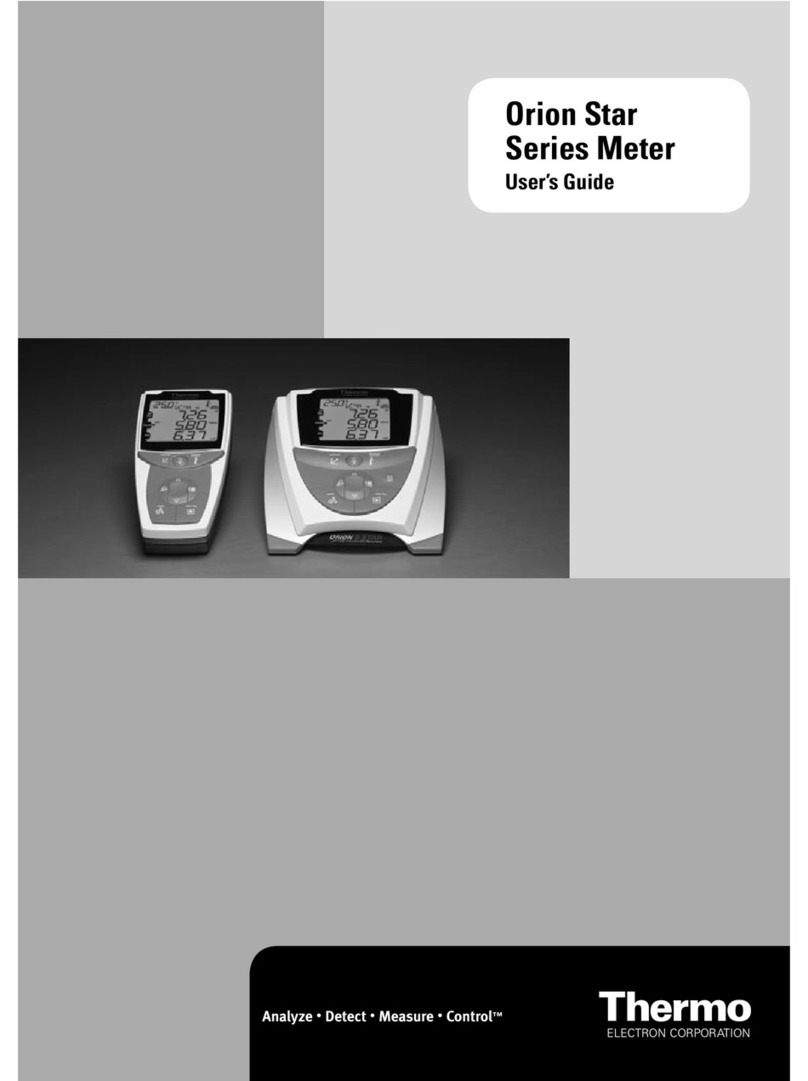
Thermo Electron
Thermo Electron Orion Star Series User manual
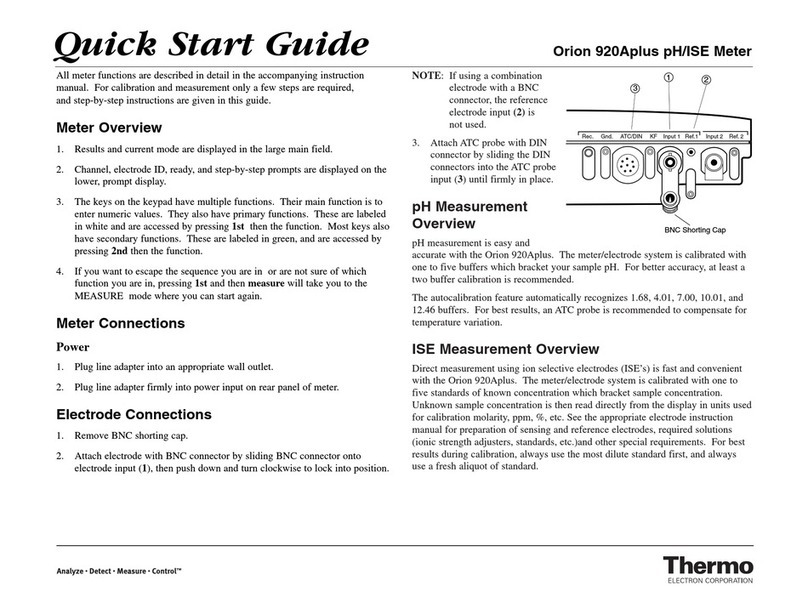
Thermo Electron
Thermo Electron Orion 920Aplus User manual
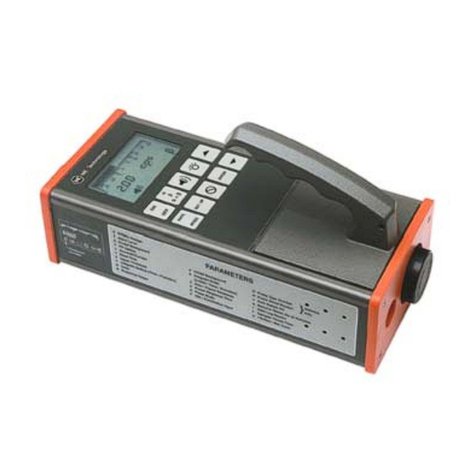
Thermo Electron
Thermo Electron ELECTRA User manual
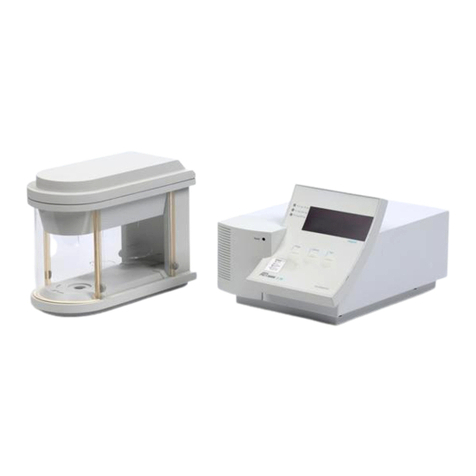
Thermo Electron
Thermo Electron Cahn C-34 User manual

Thermo Electron
Thermo Electron Nicolet 380 User manual
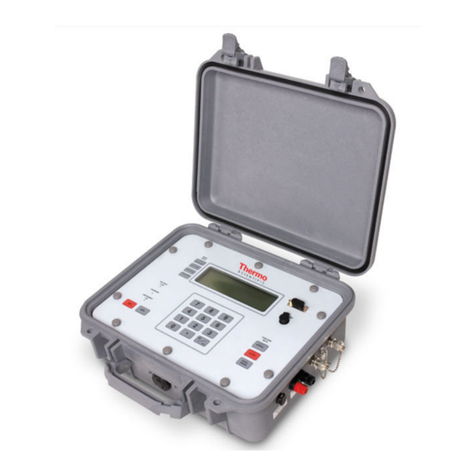
Thermo Electron
Thermo Electron Polysonics SX30 User manual
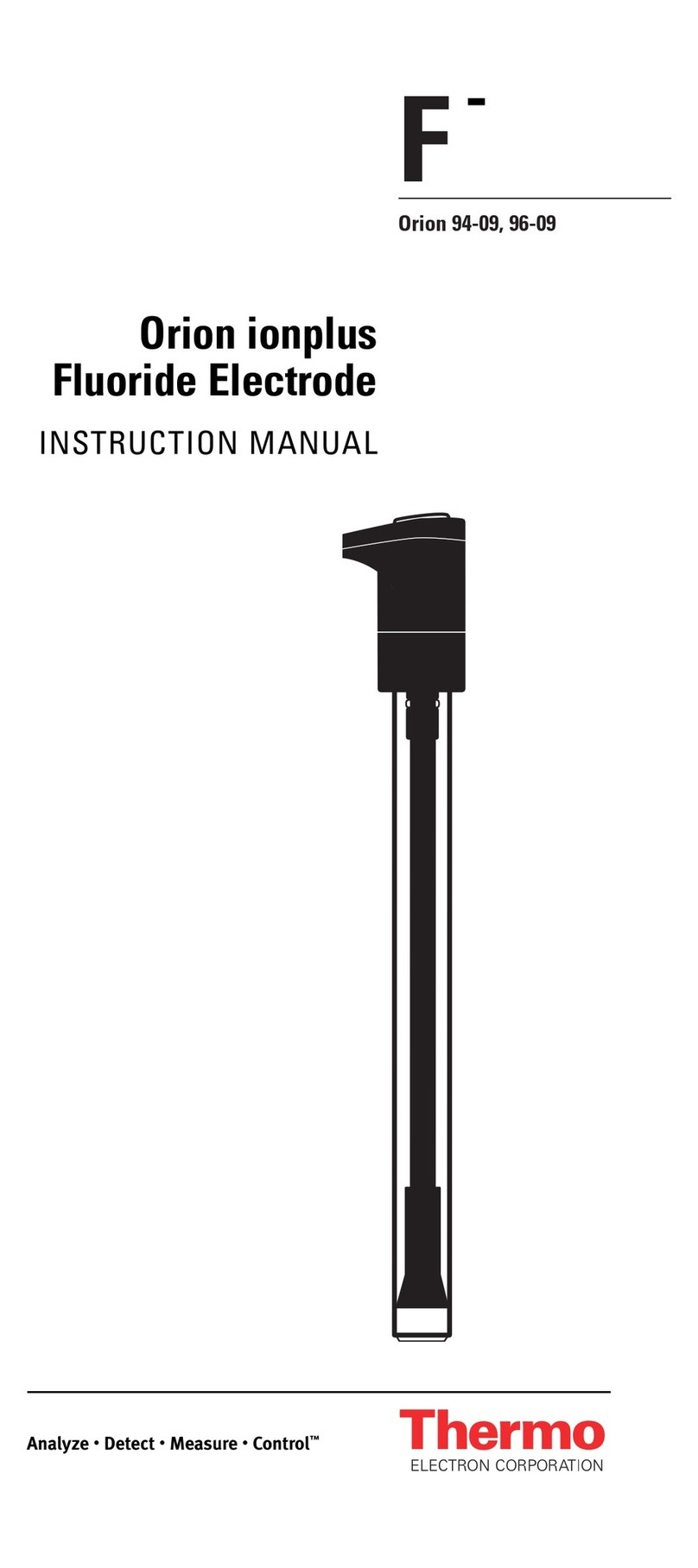
Thermo Electron
Thermo Electron 96-09 User manual

Thermo Electron
Thermo Electron Polysonics SX40 User manual
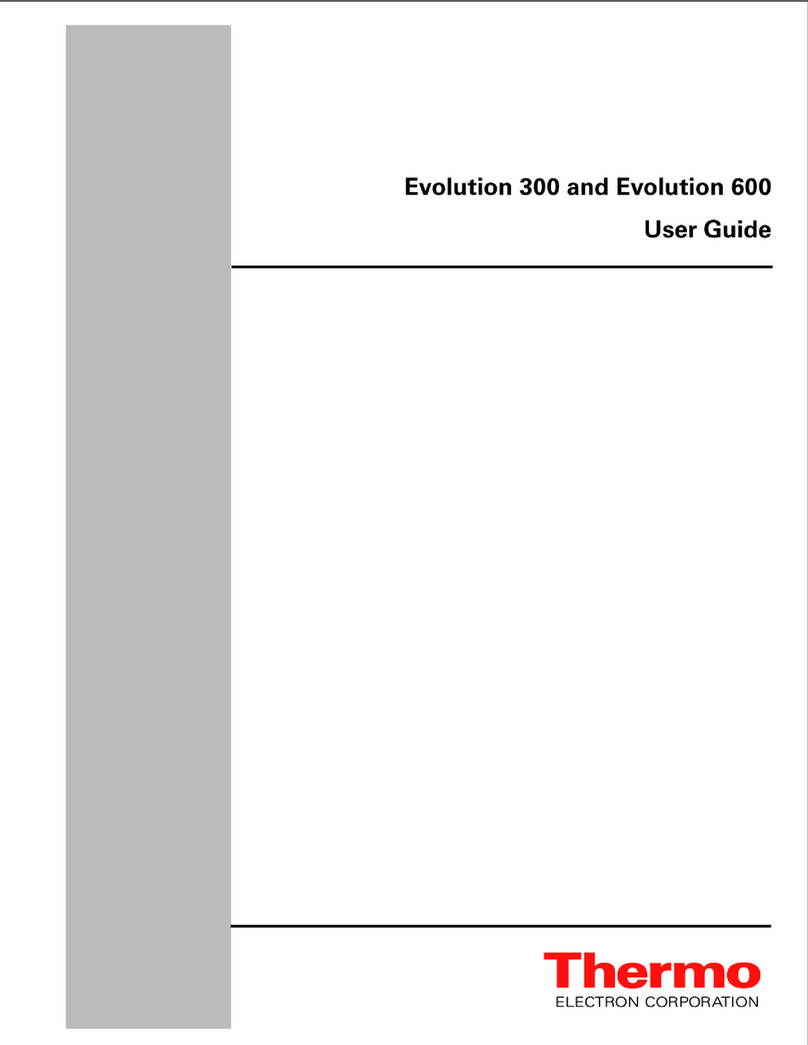
Thermo Electron
Thermo Electron Evolution 300 User manual

Thermo Electron
Thermo Electron PURE WATER Orion 1817LL User manual
